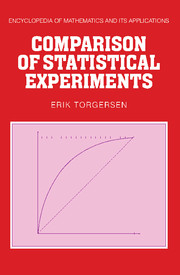Book contents
- Frontmatter
- Contents
- Preface
- Acknowledgments
- 1 Statistical experiments within the measure theoretical framework
- 2 Convexity
- 3 Two-person, zero-sum games
- 4 Statistical decision problems
- 5 Vector lattices
- 6 Deficiencies
- 7 Equivalence, representations and functionals of experiments
- 8 Comparison of linear models
- 9 Majorization and approximate majorization
- 10 Complements: Further examples, problems and comments
- List of symbols
- Author index
- Additional references
- Subject index
3 - Two-person, zero-sum games
Published online by Cambridge University Press: 05 May 2013
- Frontmatter
- Contents
- Preface
- Acknowledgments
- 1 Statistical experiments within the measure theoretical framework
- 2 Convexity
- 3 Two-person, zero-sum games
- 4 Statistical decision problems
- 5 Vector lattices
- 6 Deficiencies
- 7 Equivalence, representations and functionals of experiments
- 8 Comparison of linear models
- 9 Majorization and approximate majorization
- 10 Complements: Further examples, problems and comments
- List of symbols
- Author index
- Additional references
- Subject index
Summary
Introduction
Game theory and statistical decision theory, as treated here, are closely connected. Although the origins of most theories are hard to trace, the original major contributions to these theories are von Neumann & Morgenstern's book, Theory of games and economic behaviour, 1944 and Wald's book Statistical decision functions, 1950. Here we shall give a short introduction to those parts of game theory which have been particularly useful for decision theory. The author learned about most of the results which are presented here from the lectures and writings of Bickel, Blackwell and LeCam.
Sections 3.2 and 3.3 are intended as an introduction to the general theory of two-person, zero-sum games. Some of the standard tools for establishing minimaxity and admissibility are described in section 3.4. We have found it convenient to phrase these results in terms of a general functional rather than in terms of Bayes risk. The principles are elementary as well as useful. We have therefore organized the material so that this section may be read independently of the previous two sections as well as of chapter 1.
Values and strategies
A two-person, zero-sum game is a triple Γ = (A, B, M) where A and B are arbitrary sets and M is a function from A × B to [– ∞, ∞]. The game involves two players, player I and player II. The elements of A and B are called the (pure) strategies of player I and player II, respectively.
Information
- Type
- Chapter
- Information
- Comparison of Statistical Experiments , pp. 117 - 140Publisher: Cambridge University PressPrint publication year: 1991
